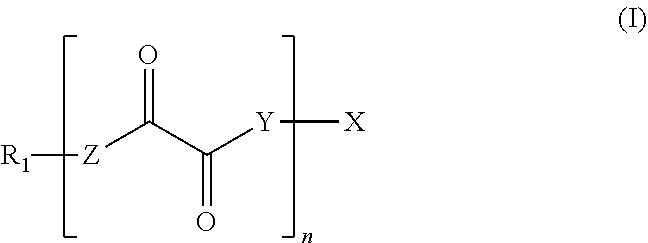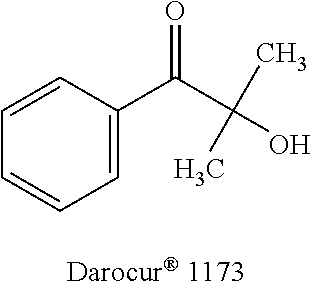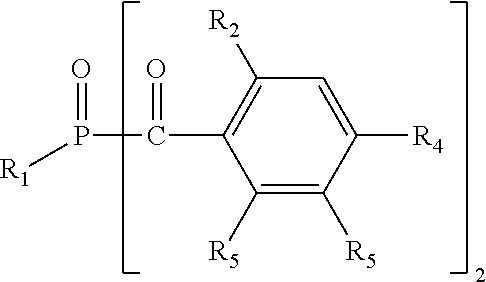Photoinitiators for light-curable compositions
- Summary
- Abstract
- Description
- Claims
- Application Information
AI Technical Summary
Benefits of technology
Problems solved by technology
Method used
Image
Examples
synthesis example 1
Synthesis of 3-bromo-3-methyl-2-oxobutanoic Acid Ethyl Ester (5)
[0062]
[0063]Into a 50 ml three-necked flask, 15 ml of CCl4 were placed. Thereto, 1 equivalent (5.62 g, 39 mmol) of 3-methyl-2-oxobutanoic acid ethyl ester was added, followed by 1 eq. (6.24 g, 39 mmol) of bromine. Then, 1.5 ml of acetic acid was used for acidification. After decoloring the solution, the reaction was quenched using approx. 30 ml of sat. NaHCO3 solution, and the mixture was transferred into a separating funnel. There, 100 ml diethyl ether and another 20 ml of NaHCO3 were added. The aqueous layer was discarded, and the organic layer was re-extracted with 50 ml of NaHCO3. The ether layer was washed with sat. NaCl solution and dried over sodium sulfate. The solvent was then removed on a rotary evaporator.
Yield: 6.94 g (79% of theory)
1H NMR (400 MHz, C6D6) δ ppm: 4.31 (q, 2 H, J=7.02 Hz); 1.95 (s, 6 H); 1.32 (t, 3 H, J=7.2 Hz).
GC-MS: 224.99[M+H]+, 143.07[M−Br]+, 122.93[M-COCOOEt]+, 70.20[M−Br-COOEt]+.
synthesis example 2
Synthesis of 3-hydroxy-3-methyl-2-oxobutanoic Acid Ethyl Ester (6)
[0064]
[0065]1 equivalent (4.46 g, 20 mmol) of 3-bromo-3-methyl-2-oxobutanoic acid ethyl ester was added to 0.5 eq. silver(I) oxide in 40 ml moist acetonitrile (ACN). The mixture was stirred for 12 hrs, and the light-grey precipitate was removed by filtration. The solution was then diluted using 100 ml of water and extracted with 200 ml of ether, and the organic layer was dried over sodium sulfate. After removing the solvent, the crude product was subjected to fractional distillation (120° C., 25 mbar).
Yield: 1.50 g (93% of theory)
1H NMR (400 MHz, C6D6) δ ppm: 3.85 (q, 2H, J=7.31 Hz); 2.94 (bs, 1 H); 1.30 (s, 6H); 0.83 (t, 3H, J=7.09 Hz).
GC-MS: 161.16[M+H]+, 143.20[M—OH]+, 115.16[M—OEt]+, 87.09[M-COOEt]+, 59.06 [(CH3)2OH]+.
synthesis example 3
Synthesis of N,N′-dimethylamino Pyruvate (10)
[0066]
[0067]In a 100 ml three-necked round-bottom flask, 2,5 eq. N,N-dimethyl ethanolamine were added dropwise from a septum to a mixture of 1 eq. 3,3-dimethyl-2-oxobutanoyl chloride in 10 ml dichloromethane while cooling using an ice bath. After the addition had been completed, stirring was continued for 48 hrs at room temperature. After the reaction had been completed, the solvent was removed using a rotary evaporator. The product was obtained as a clear oil by Kugelrohr distillation at 1.2 mbar and 94° C.
Yield: 177 mg (17% of theory)
1H NMR (400 MHz, C6D6, ppm): 4.11 (t, 2 H), 2.29 (t, 2H), 2.02 (s, 6 H), 1.16 (s, 9 H).
[0068]2.5 eq. N,N-dimethylethanolamine were added dropwise from a septum to a mixture of 1 eq. 3,3-dimethyl-2-oxobutanoyl chloride in 10 ml dichloromethane. After the addition had been completed, stirring was continued for 48 h at room temperature. After the reaction had been completed, the solvent was removed using a rot...
PUM
| Property | Measurement | Unit |
|---|---|---|
| Percent by mass | aaaaa | aaaaa |
| Mass | aaaaa | aaaaa |
| Mass | aaaaa | aaaaa |
Abstract
Description
Claims
Application Information
 Login to View More
Login to View More - R&D
- Intellectual Property
- Life Sciences
- Materials
- Tech Scout
- Unparalleled Data Quality
- Higher Quality Content
- 60% Fewer Hallucinations
Browse by: Latest US Patents, China's latest patents, Technical Efficacy Thesaurus, Application Domain, Technology Topic, Popular Technical Reports.
© 2025 PatSnap. All rights reserved.Legal|Privacy policy|Modern Slavery Act Transparency Statement|Sitemap|About US| Contact US: help@patsnap.com



